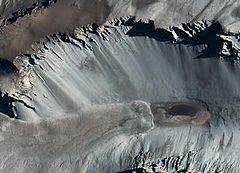- Don Juan Pond
-
Don Juan Pond 
Satellite photo Location Eastern Antarctica Coordinates 77°33′55″S 161°11′26″E / 77.56528°S 161.19056°ECoordinates: 77°33′55″S 161°11′26″E / 77.56528°S 161.19056°E Lake type hypersaline lake Basin countries (Antarctica) Max. length 300 m Max. width 100 m Surface area 0.03 km² Water volume 3 000 m³ Frozen almost never Islands none Settlements Vanda Station
(14 km to the east)Don Juan Pond, also called Lake Don Juan, is a small and very shallow hypersaline lake in the west end of Wright Valley (South Fork), Victoria Land, Antarctica, 9 kilometres (5.6 mi) west from Lake Vanda. It is wedged between the Asgard Range in the south and the Dais in the north. On the west end there is a small tributary and a feature that has been described as a rock glacier. Don Juan Pond is the saltiest body of water on earth with a salinity level of over 40%.[1][2]
Don Juan Pond was discovered in 1961. It was named for two helicopter pilots, Lt Don Roe and Lt John Hickey, who piloted the helicopter involved with the first field party investigating the pond. On that initial investigation, the temperature was −30 °C (−22 °F) and the water remained in a liquid state.
Contents
Salinity
Don Juan Pond is a shallow, flat-bottom, hyper-saline pond. It has greater salinity than the Dead Sea or even Lake Assal (Djibouti) (the same is true for Lake Vanda and perhaps other lakes in the McMurdo Dry Valleys). It has been claimed that the salinity in Don Juan Pond is over 18 times the ocean's salinity, compared to that of the Dead Sea at about 8 times that of the ocean. The fact that it is the only one of the Antarctic hypersaline lakes that almost never freezes is an indication of its top rank in salinity among the world's lakes.
The salinity is high enough that it doesn't freeze in winter. Therefore, unlike other lakes and ponds in the dry valleys, it has no ice cover. It has been described as a groundwater discharge zone. The dominant ions in solution are calcium and chloride. The area around Don Juan Pond is covered with sodium chloride and calcium chloride salts that have been precipitated as the water evaporated. Area and volume of Don Juan Pond varies over time. According to the USGS topo map published in 1977, the area was approximately 0.25 km2 (62 acres), However, in recent years the size of the pond has shrunk considerably. The maximum depth in 1993–94 was described as "a foot deep" (30 cm). In January 1997, it was approximately 10 centimetres (3.9 in) deep; in December 1998 the pond was almost dry everywhere except for an area of a few tens of square meters. Most of the remaining water was in depressions around large boulders in the pond.[3]
The calculated composition for its water is CaCl2 3.72 mol/kg and NaCl 0.50 mol/kg, at the temperature of -51.8°C.[1] That would be equivalent to 413 g of CaCl2 and 29 g of NaCl per kg of water.
References
- ^ a b G.M. Marion (1997). "A theoretical evaluation of mineral stability in Don Juan Pond, Wright Valley, Victoria Land". Antarctic Science 9 (01): 92–9. doi:10.1017/S0954102097000114. http://journals.cambridge.org/action/displayAbstract?fromPage=online&aid=220255.
- ^ "Don Juan Pond and Lake Vanda Photo Gallery by Suze at pbase.com". http://www.pbase.com/antarctic_suze/don_juan_pond.
- ^ http://www.mcmlter.org/data/lakes/locations/lakedsc.dat
Literature
- Yamagata, N., T. Torii, S. Murata. "Report of the Japanese summer parties in Dry Valleys, Victoria Land, 1963–65; V – Chemical composition of lake waters". Antarctic Record 29: 53–75.
External links
- Great Zoom into Don Juan Pond, Antarctica
- Siegel, B. Z.; McMurty, G.; Siegel, S. M.; Chen, J.; Larock, P. (30 August 1979). "Life in the calcium chloride environment of Don Juan Pond, Antarctica". Nature 280 (5725): 828–9. doi:10.1038/280828a0. http://www.nature.com/nature/journal/v280/n5725/abs/280828a0.html.
- McMurdo Dry Valleys MCM Lakes Data
- U.S. Geological Survey Geographic Names Information System: Don Juan Pond
- Don Juan Pond GigaPan picture
Categories:- Lakes of the Ross Dependency
- Saline lakes
- Endorheic lakes of Antarctica
- McMurdo Dry Valleys
Wikimedia Foundation. 2010.

